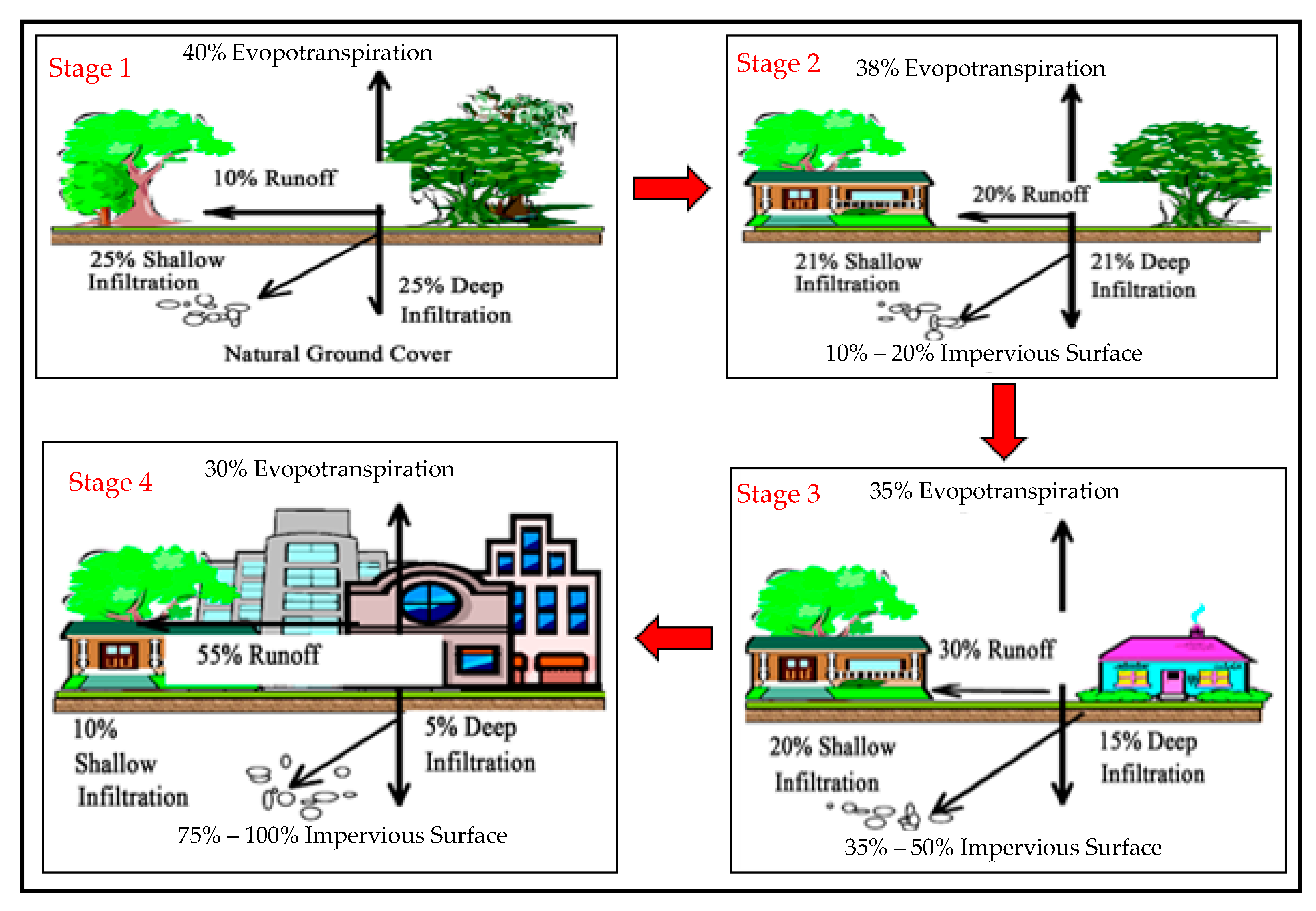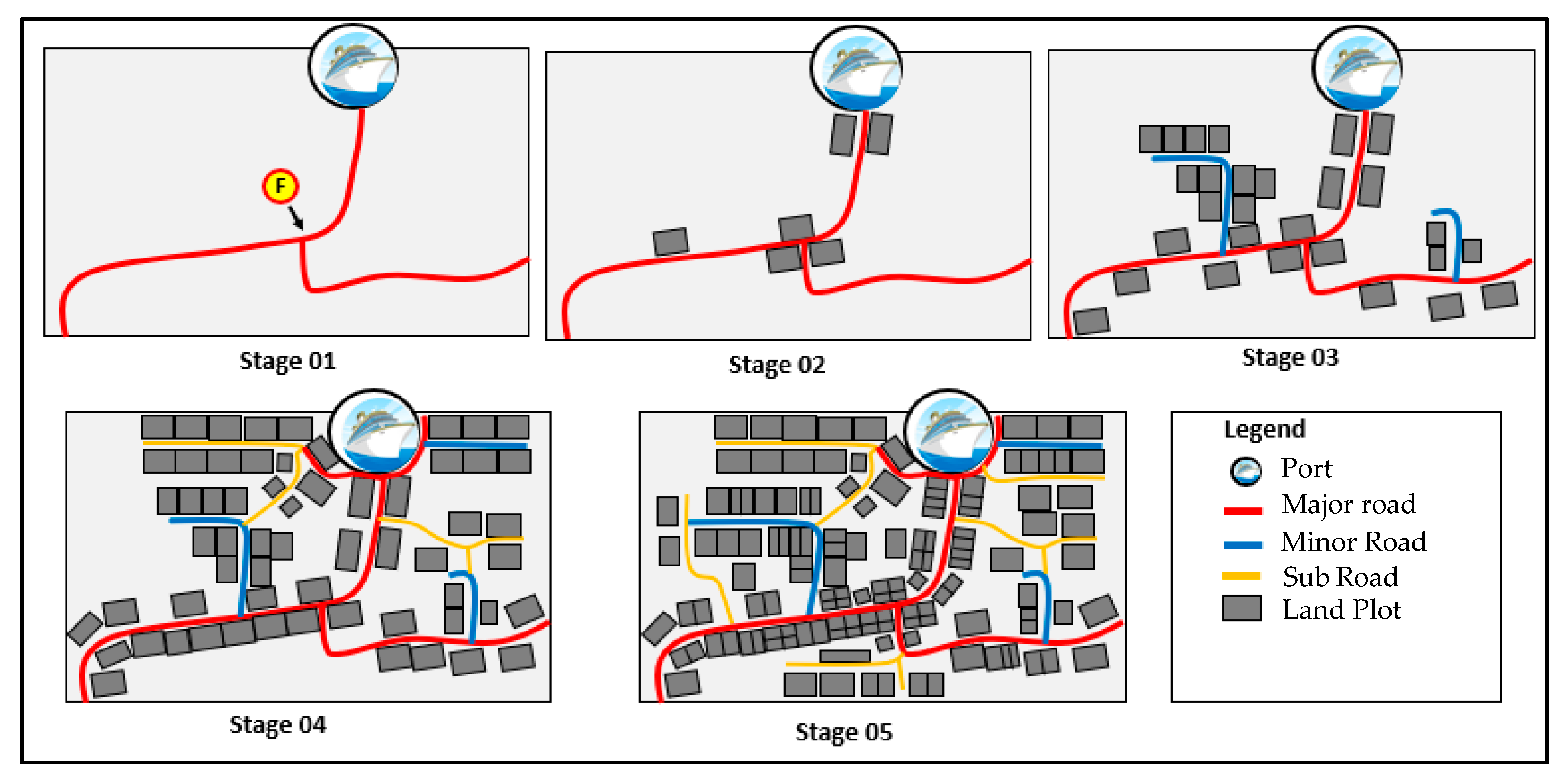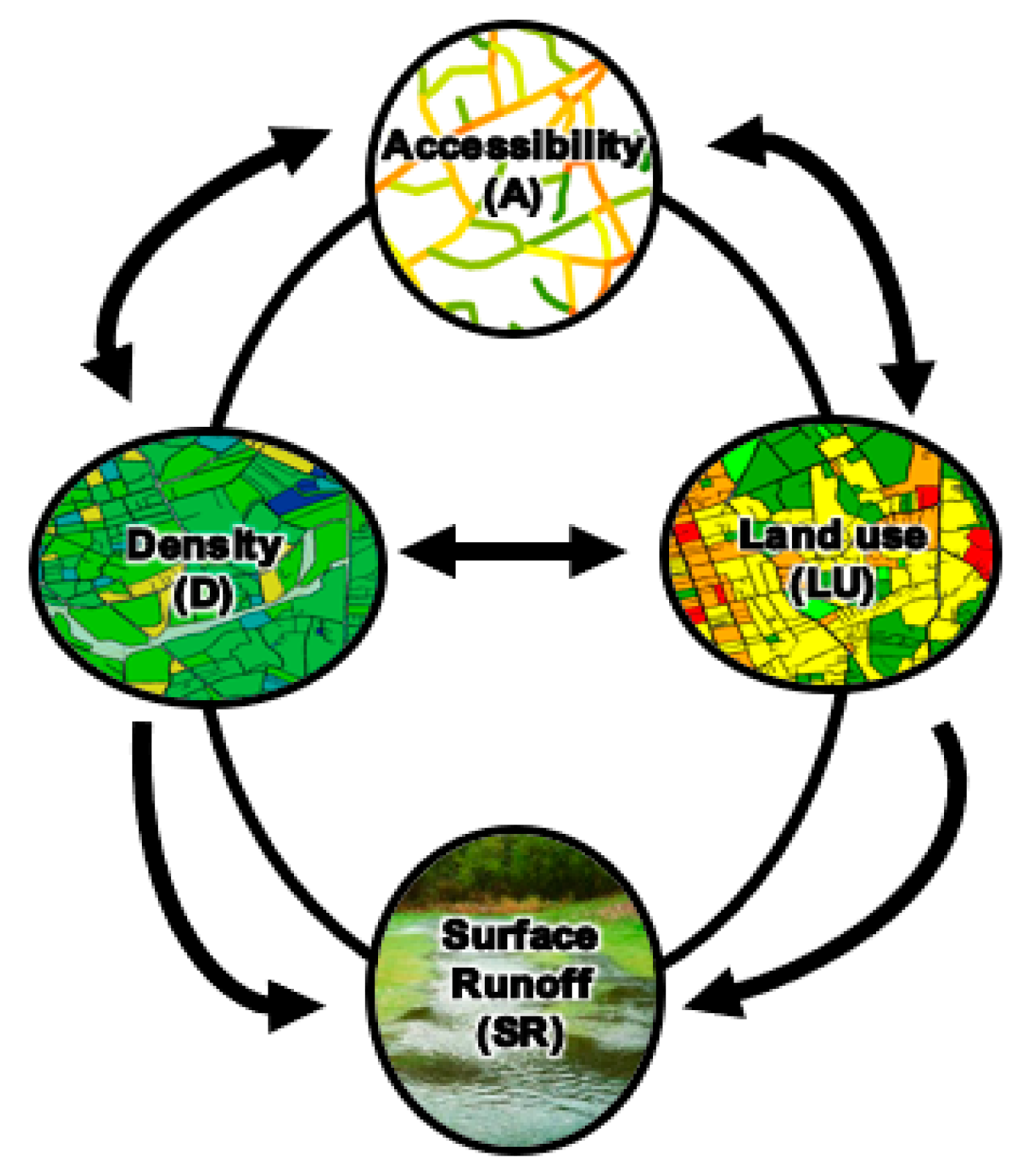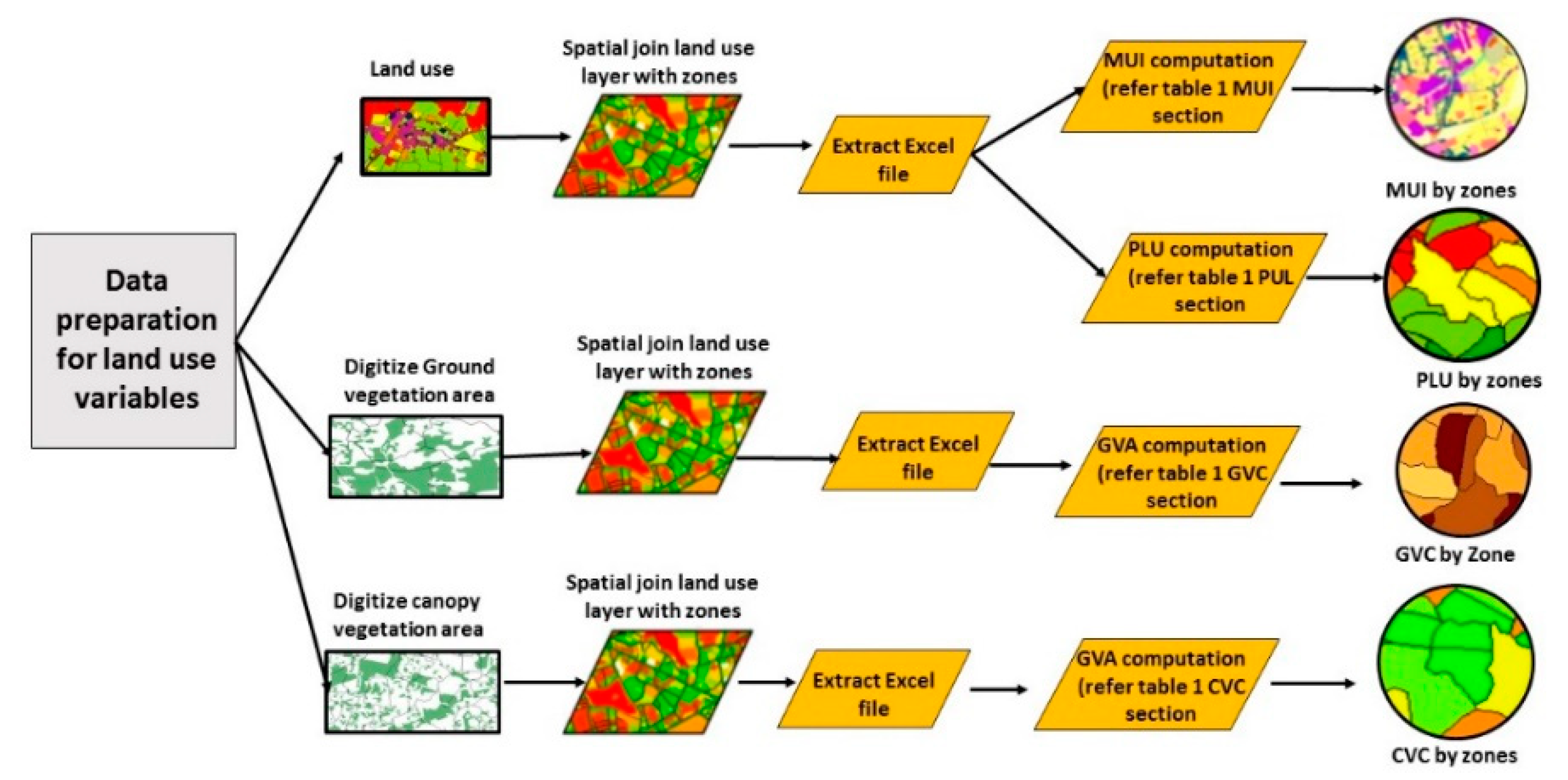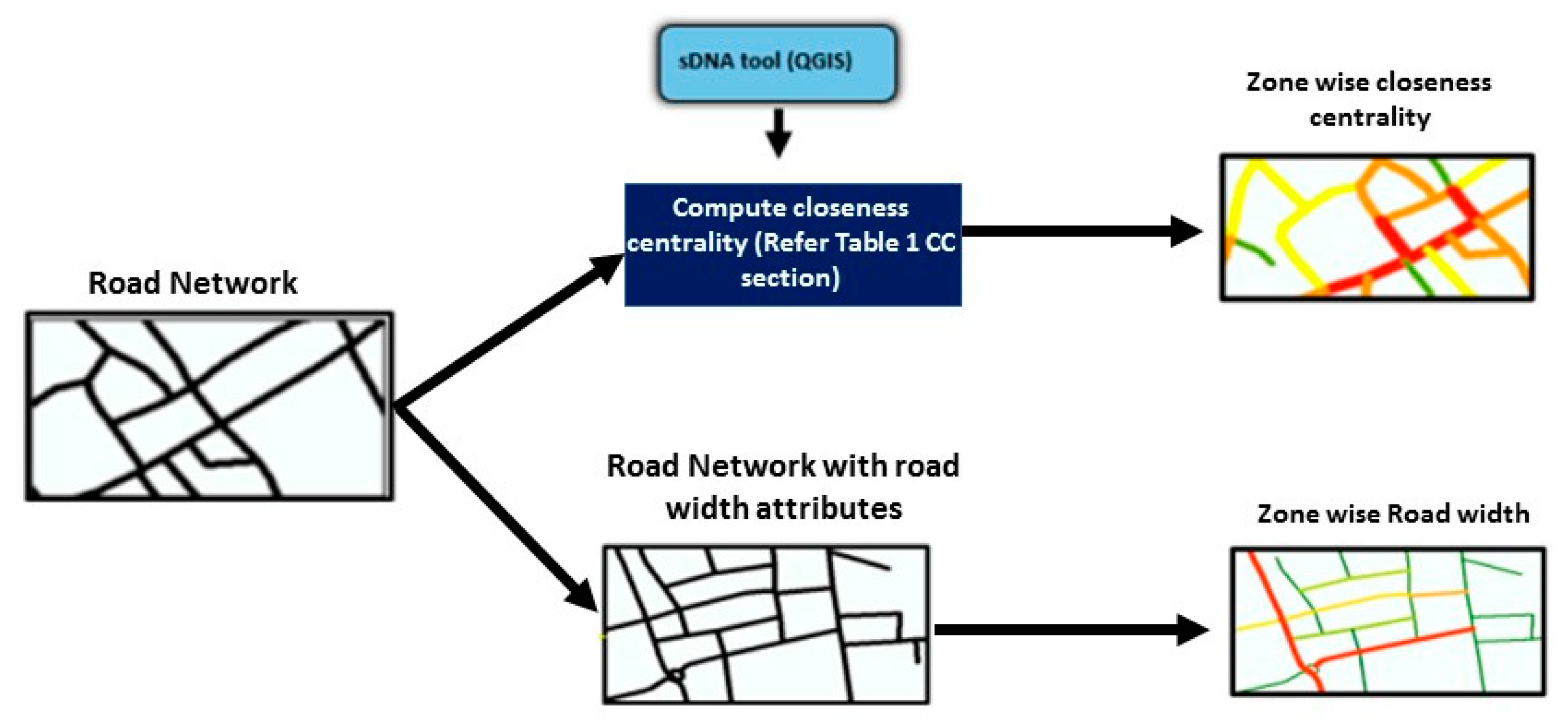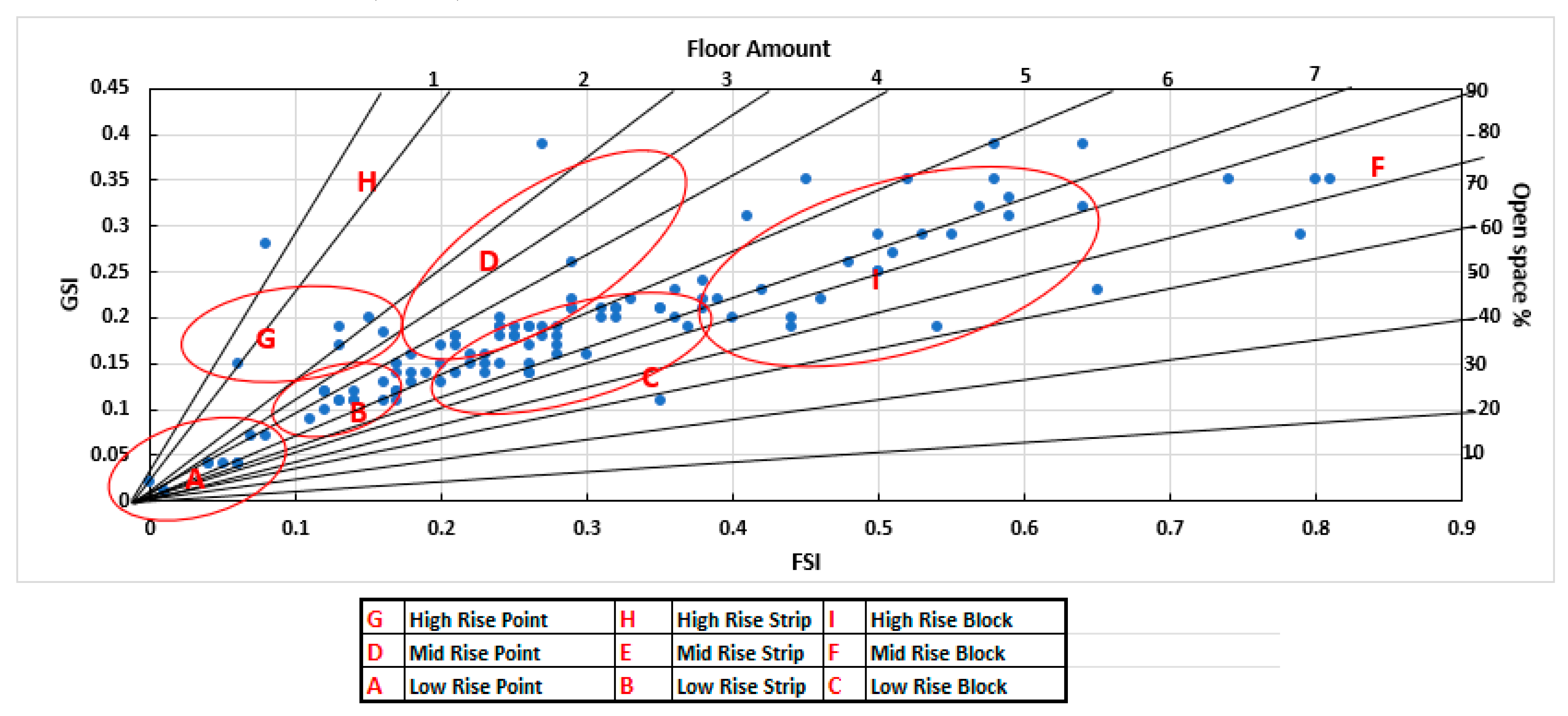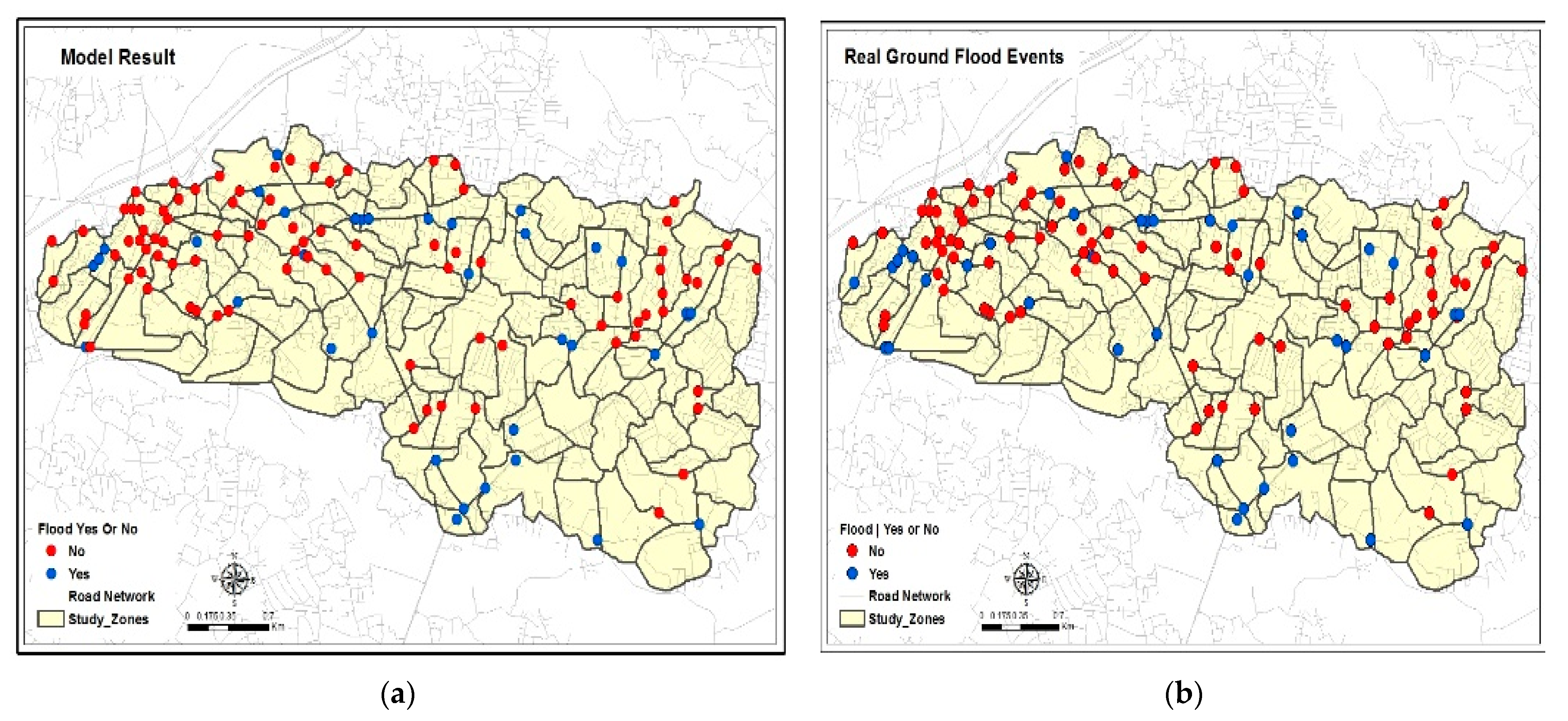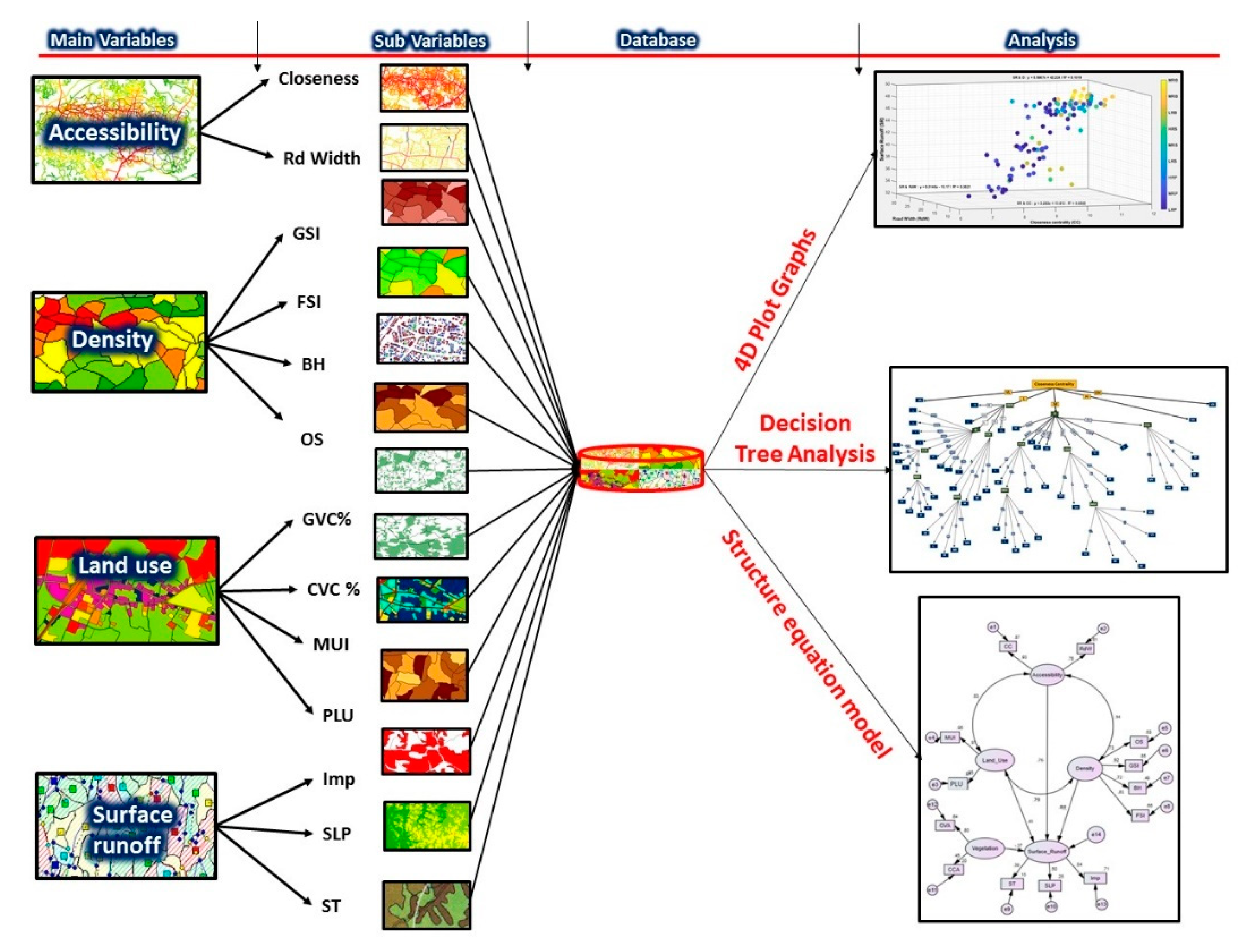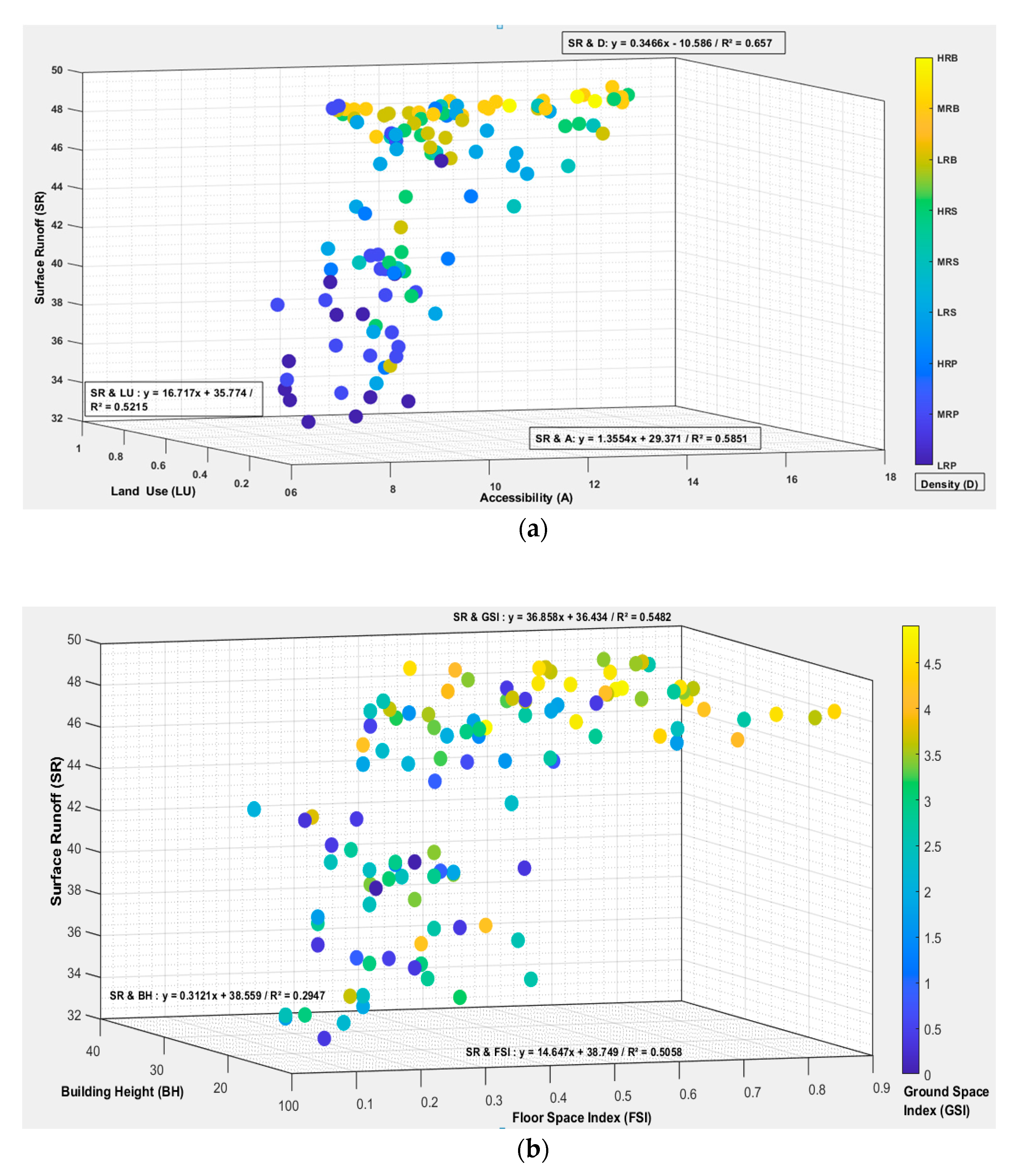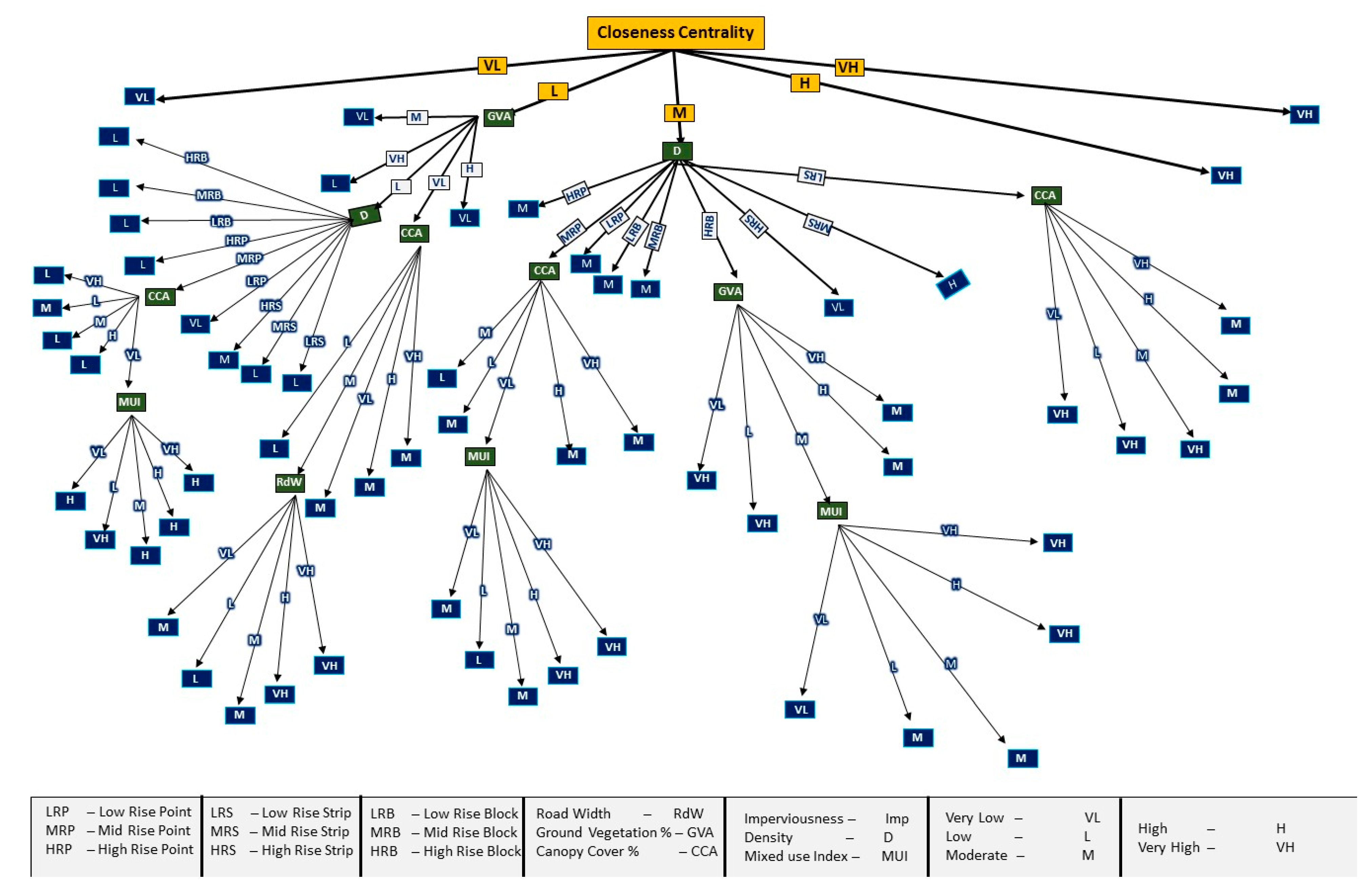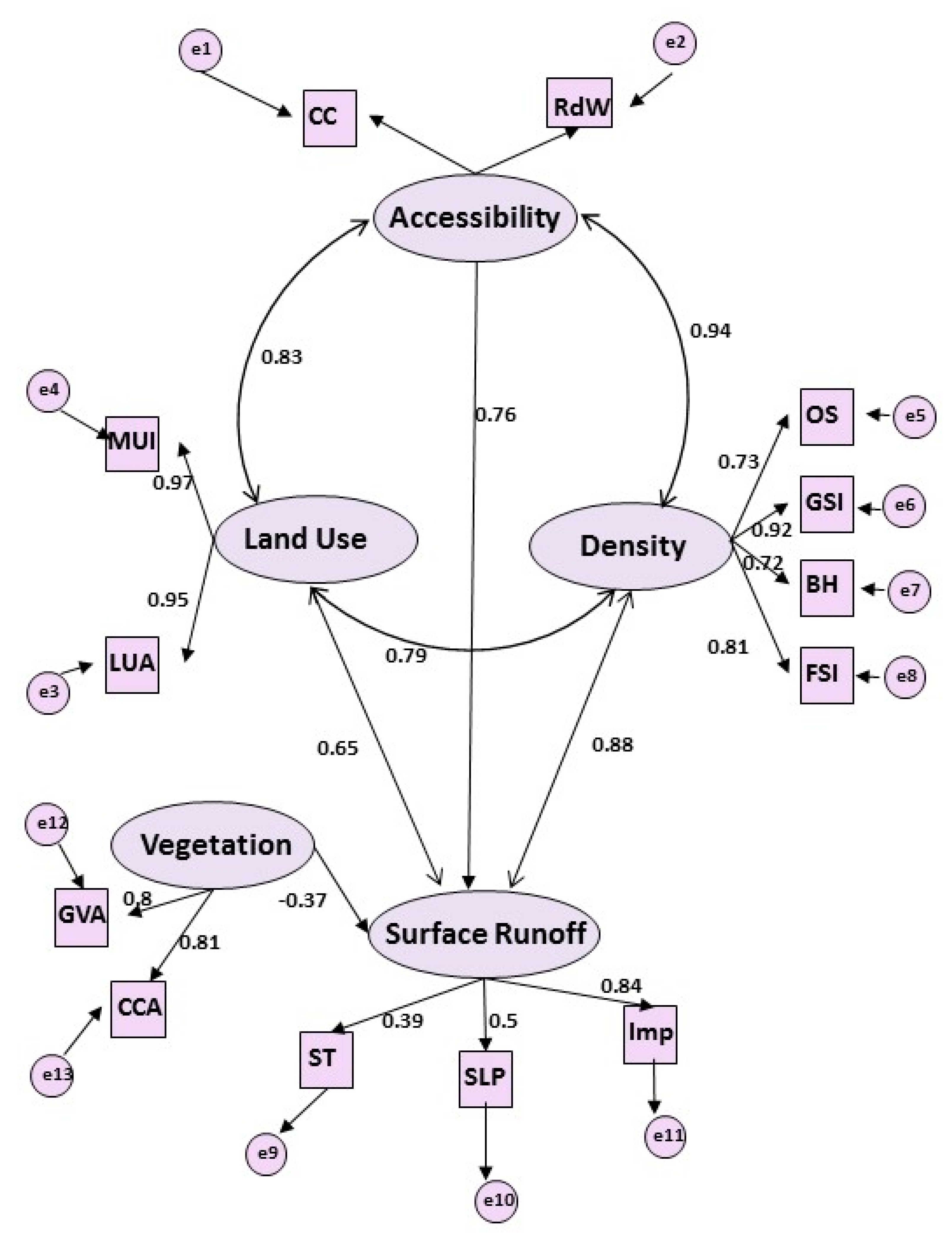1. Introduction
Issues related to rapid urbanization have become a broadly discussed topic during the past two decades due to its negative impacts on livelihoods and functionality, as shown by clear evidence. Urban flooding, congested living spaces, and various types of pollutions are among the key issues in the current urban context. An extensive number of studies have shown that higher surface runoff directly influences the occurrence of flood events in the urban context [
1,
2,
3]. Kang and Yeom [
4] argued that the shape of the urban form is defined by the behavior of the urban components such as land use, accessibility, and the density and patterns of the movements. In some studies, land use behavior, accessibility, and density were identified as the determinants of the shape of the urban form and were therefore responsible for the emergence of certain outcomes, such as the attraction and movement of populations, changes in the surface runoff volume, and urban flooding events in the urban context [
5,
6].
In 2002, over 50% of the global population was declared as residing in urban areas, thus enabling the recognition of urban flooding as a consequence of the unplanned configuration of the components of the urban form [
7,
8,
9].
The global population is growing at an alarming rate, reaching a record of 7.67 billion in 2019, which was surpassed by 7.71 billion in 2020 [
10]. In contrast, however, habitable land on Earth is a limited resource, and is incapable of expanding in proportion to the population growth. This scarcity has led to ongoing competition among inhabitants to obtain land and access to infrastructure facilities with the purpose of improving their living conditions. The competition for land has triggered urbanization, with high rates of conversion of land use from green to brown and high building densities all over the world [
11,
12].
The increasingly built-up fabric in the urban context hinders the ecosystem’s ability to retain and infiltrate excessive precipitated water, causing urban flooding [
13].
Figure 1 depicts the associations between land use, accessibility, and density with surface runoff, and how these four-dimensional associations create urban flooding incidents in the urban context.
Changes in the movements and attractions of inhabitants in the forest ecosystem increase accessibility opportunities with developments over time. Therefore, new land uses, activities, and built-up areas, including buildings and other infrastructure facilities, are gradually increased as vegetation cover is reduced. Therefore, the imperviousness of the area is increased by up to 35 to 50%. Surface runoff is increased by up to 30% due to the higher building density and solid surface coverage during the third stage. The fourth stage represents a highly urbanized area having 75–100% impervious surface and more than 55% surface runoff. This phenomenon is predominantly due to the growth in the highly built-up surface, which covers the soil using solid materials that have very low infiltration and evaporation, and the removal of vegetation for the erection of buildings. The built-up surface growth is encouraged by accessibility, land use, and density [
15]. Therefore, the surface runoff rate increases in proportion to the built-up surface coverage improvements [
16,
17]. A number of studies have explained the requirement to explore the realtionships between major urban form componants, such as land use, accessibility, density, and surface runoff, to develop resilient future cities around the world.
Dempsey et al. [
18] explained that land use, accessibility, and density components play key roles in shaping the image of the urban form [
19]. Furthermore, Kang et al. [
4] identified that the effects of a highly developed urban form with a superior land use diversity, accessibility, and density on urban flooding is due to two aspects—namely, the proportionate increment in an impermeable land surface and the decrement in the land cover that has a natural drainage function.
Higher land use diversity, accessibility, and density increase the level of urbanization. This reduces green land cover, which is capable of absorbing a significant amount of incoming precipitation and retain it to be directed gradually to the subsurface water flow [
20]. Additionally, a higher impermeable surface cover confines the penetration of storm water and significantly increases the surface runoff volume and peak discharge, leading to an increased risk of urban flooding [
21,
22].
Urban form componants are perceieved to be inter-dependant, acting as a loop and driven by accessibility compared to land use or density in a given urban form. The key reason for higher accessibility is defined as a higher level of attraction in any given area. The change in land use occurs as a result of the attraction created by accessibility. Hence, land use and accessibility in combination create additional attraction for people. The next decisive factor is density, which changes with land use and accessibility [
23]. Densification of the urban form can be increased by improving the street network and accessibility on multiple scale levels combined with high public transport options [
24,
25]. Strohbach et al. [
26,
27] explained that higher densification results in increased impermeable surfaces and a higher surface runoff, which in turn influences the occurrence of flooding incidents in an urban context. These studies mainly explain the influence of the topological characteristics of accessibility responsible for changing surface runoff and creating flood events.
Ye & Nes [
28] highlighted the interdependencies between street network configuration, building density, and land use mixture when explaining the transformation of the urban form. They argued that the level of combination between land use, accessibility, and density is capable of interpreting the maturity of a particular city. Highly matured cities have more diversified land use, higher accessibility, and higher densification in the urban form. Aforementioned studies explain that higher accessibility and highly mixed land use create densified urban forms that can be identified as highly urbanized areas comprising of small plot sizes, with a large cumulative percentage of impervious surfaces, less vegetation cover, etc. Advancing a step further, Chen, Zhou, Zhang, Du & Zhou [
8] have proposed a relationship between density and surface runoff based on the mean parcel size, building coverage, and building setback. They provided evidence to prove small-sized plots and areas consist of higher plot coverage, which are in line with higher accessibility and a higher surface runoff, with a greater possibility of flood events due to low infiltration and evapotranspiration. Nevertheless, these studies mainly explain the influence of density on the surface runoff out of the other urban form components which influence the change in runoff volume. Furthermore, Pertiwi, Hisyam and Yofianti [
8], Ref. [
29] explained that the runoff rate is changing based on land use conversions, and the degree of the surface runoff change depends on the native land use and converted land use. The highest surface runoff improvement has been identified from forest to built-up land cover conversion. Hill [
30] explained that the runoff coefficient is a standard value for different land uses, but he argues that the coefficient value cannot be a standard value and essentially changes with the density level of land use. In further emphasis, the same land use can indicate different runoff coefficients under different density levels of land use. The concurrent knowledge vividly explains how land use, accessibility, and density influence the changes in surface runoff and flood incidents in an urban context. Therefore, as Conzen [
31] emphasizes, urban planners, in dealing with flooding in an urban context, need to have a better understanding on the entire image of the urban form and its outcomes, which have been created by the urban form components.
The study has identified two main limitations in the contemporary literature. Firstly, no attempts were found to test the interrelationship between the four dimensions: land use, accessibility, density, and surface runoff in the events of urban flooding. Available knowledge merely explains how surface runoff depends on land use, accessibility, and density in isolation. All four dimensions have not been studied in a common context within a single study framework. Furthermore, the identification of the compound influence of each variable on the occurrence of urban flooding is crucial for decision makers to deliver adjustments to achieve the expected urban form. The second limitation is the lack of ground level verification of the findings. Existing knowledge has utilized different models to capture the surface runoff of the urban form. Nevertheless, those studies have not been verified with the field information.
This paper attempts to overcome the mentioned limitations noted in the domains related to urban planning, through a novel theoretical framework, to capture the four dimensional direct, indirect, and moderate relationships between land use, accessibility, density, and surface runoff in an urban context.
The theoretical framework of the study is explained in the next section. The third section focuses on the methods and materials extracted from contemporary literature. The analysis and results are aligned in the fourth section, which is comprised of three types of analysis to explore the relationships and influence of the variables. Conclusions and recommendations are presented at the end of the paper.
Theoretical Framework
The objective of the study is to analyze the relationship between land use, accessibility, density, and surface runoff and identify the influence of each variable on other variables in a common context. The theoretical framework of the study has been developed based on the four notions, i.e., natural movement theory, the transport land use feedback cycle, natural occupancy theory, and the infiltration concept under the water balance model. The theory of the movement economy explains that the “configuration of the urban grid itself is the main generator of the patterns of movement”. Commercial land uses are then located to take the opportunity offered by the passing trade and may well act as multipliers on the basic pattern of ‘natural movement’ generated by the grid configuration. Therefore, Configuration (C) is identified as a main driving force to direct movements and attractions of an urban context. Furthermore, a set of studies have been carried out to understand the relationship between the structure of the urban grid (Configuration) and movements (M) of the people based on the graph theory [
32]. Hillier, Perm, Hanson, Grajewski, & Xu [
23] have conducted a study based on the space syntax tool to prove that road networks that bifurcate into nodes and links can represent the urban block structure (Configuration) [
33].
Therefore, confutation can be represented by the road network, which provides accessibility to the urban form. Furthermore, as the transport feedback cycle explains, the transport system increases accessibility to the urban areas and provides multiple effects on the land use to attract more people and new land uses to increase the diversity of land use distribution. A series of studies have shown evidence to prove the relationship between accessibility and land use (LU) [
18,
34].
As the natural occupancy theory explains, movements and attractions are directed by the configuration (Accessibility) of the urban form. Therefore, attraction and movements provide multiple spatial effects on the land use (LU) and density (D) [
35,
36]. Furthermore, highly accessible configuration and land use create more density in the urban form.
Figure 2 depicts the natural process of a single land evolution into a complex urban form, based on the changes of the configuration (Accessibility) land uses and movements. Configuration attracts people, and new activities are established to gain the attraction of people. New land uses are established, and single land plots are divided into more land plots. Configuration and land use are influenced to create the density of the context [
37].
According to the aforementioned knowledge, both land use and density act as a function for accessibility. Typically, highly accessible locations have a higher land use diversification, with more attraction for people and also a highly densified urban fabric which includes a higher land demand and low land plot sizes. Hence, it directly changes the surface of the urban area with solid materials such as concrete, tar, etc. As the water balance model explains, at the forest vegetation cover, the infiltration level is more than 80% of the precipitation, whereas the highly urbanized urban surface has only a 10% infiltration, when the vegetation cover is changed into a densified solid surface coverage-based land [
14]. This means that the runoff level is very high when a vegetation cover is converted to a density solid surface cover built-up land in the urban form. Hence, land use and density control the surface runoff of the urban form [
38,
39]. Further series of studies have discovered a higher relationship between surface runoff and land use [
29] and density [
40].
Aforementioned theories and empirical studies have created the argument that land use and density change accordingly with accessibility changes. Higher accessibility motivates an increase in the diversity of land use by increasing demand for the context. Hence, a higher number of people are attracted and demand is created for the available space. As a result, available open land and built-up land is subdivided into smaller land plots which increase the density and impermeability of the urban surface. Therefore, the potential of infiltration is reduced because of the higher built-up cover. Consequently, the increase in surface runoff volume and inundation have the potential to create flood risk for the urban context.
Therefore, the objective of this study is to analyze the relationship between land use, accessibility density and surface runoff in one context. Available knowledge which explains theoretical relationships have been compiled in
Figure 3, with the directions of the influence by each variable. The study focuses on testing those relationships and the influence of each main variable and sub-variables on other variables.
The next section explains the methods of the main and sub-variables’ quantification. Those methods have been derived from the available knowledge related to this study.
4. Discussion
The findings of this study contribute, on one hand, to sustain some of the arguments developed by the previous studies, and on the other hand, contribute newly developed evidence to studies related to the four-dimensional relationship between land use, accessibility, density, and surface runoff. Hillier [
33], as well as Yu and Akkelies [
8], established that land use, accessibility, and density have an interrelationship and that this relationship creates a major influence on the occurrence of urban-form-related incidents such as urban flooding. The results of this study also verify the interrelationship between land use, accessibility, and density. In addition, this study distinguishes that interrelationship has a significant influence on changing surface runoff which is a major contributor to create urban flood incidents.
Previous studies [
15,
28,
32,
41,
45] argued that land use and density can change based on the changes in accessibility. However, this study found that it is more effective to incorporate both topological and mobility characters of accessibility to capture the real influence of accessibility on land use, density, and surface runoff. The result recorded the relationship between accessibility with land use, density, and surface runoff as 0.83, 0.94, and 0.76, respectively. Furthermore, previous studies [
8,
40] have shown that a higher density reduces the capability of water infiltration by covering the surface with solid materials. The results of this study revealed that higher accessibility encourages the increase in the land use mix, density, and surface runoff in the urban context. The novel finding of this study reveals the influence levels of accessibility, land use, and density on surface runoff. The density has a 0.88 influence on the surface runoff, which represents the highest influence change in surface runoff in an urban context to create urban flooding incidents. The influence value indicates that when there is a change in 1 unit of density, it influences a change of 0.88 in the surface runoff. Nevertheless, density change is based on the accessibility and land use. The results show that accessibility and land use have influences of 0.94 and 0.79, respectively, to change density. Closeness centrality is the leading sub-variable to change surface runoff out of the other 12 sub variables. It shows a 0.75 influence to change surface runoff as an individual sub-variable under the topological character of accessibility. Moreover, the decision tree analysis shows that there is more than 80% accuracy between the four variables that occur in different surface runoff events based on the relationship between the four dimensions. Finally, the study has tested the four-dimensional theoretical relationship in one context to comprehend the relationship between these four dimensions and the influence of each variable on other variables.
5. Conclusions and Recommendations
The objective of this study was to evaluate the four-dimensional relationship among land use, accessibility, density, and surface runoff in urban areas. Existing studies have not given considerable attention on the urban form components (land use, accessibility, and density) that create a complex and dynamic influence to change surface runoff in an urban context. Moreover, available studies have not attempted to analyze these four dimensions together. To overcome these limitations, this study utilized the 4D diagram technique to identify the relationship between four dimensions and sub-components of these dimensions. Furthermore, the patterns of the data set are read by the decision tree analysis. The influence of each variable on other variables is elaborated by utilizing the structural equations model (SEM).
The results of the study can be summarized into four main findings. First, the tested theoretical framework is accurate and confirmed with the result of higher density and land use mixed study zones located with higher accessibility. Additionally, higher surface runoff locations are also predominantly located with those zones which represent higher accessibility, land use, and density. The reverse scenario also shows the same pattern. Second, the dataset represents predominantly urban characteristics with higher accessibility, density and land use. Therefore, more than a 31% possibility is recorded with the high and very high-level surface runoff occurrences with the given dataset. A strong water management model detected flooding nodes within those zones. Therefore, this finding strongly proves that high accessibility, land use and density create more possibilities of increasing surface runoff and urban flood incidents. Third, according to the decision tree analysis, this possibility is led by the classlessness centrality and density. Fourth, structure equation model indicates that closeness centrality as an individual sub-variable has a higher influence on changing the surface runoff. According to the theoretical framework, closeness centrality comes under the accessibility parameter. It is capable of influencing changes in density and land use with a higher percentage. Therefore, closeness centrality can be identified as a core sub-variable of the entire system.
According to the findings of the study, decision makers can utilize these findings to understand the urban form and its components, the behavior of the urban form and the outcomes of the behavior, and how those components influence change in other variables and outcomes of the urban form. The understanding of dynamic behaviors of the urban form helps the urban planners to make their decisions more confidently in a logical framework. The identification of the complexity of the urban form and the influence of individual components provide better support to plan strategies and zoning regulations to control and encourage developments. According to the current trends of accessibility, land use and density, planners can predict how surface runoff will change based on the current trend and what kind of strategies and regulations should be formulated. Therefore, this study concludes that this framework will be an effective tool for decision makers in the field of land use planning, resilience city planning, transport planning, and for those who are focusing on developing resilient cities in the world.
